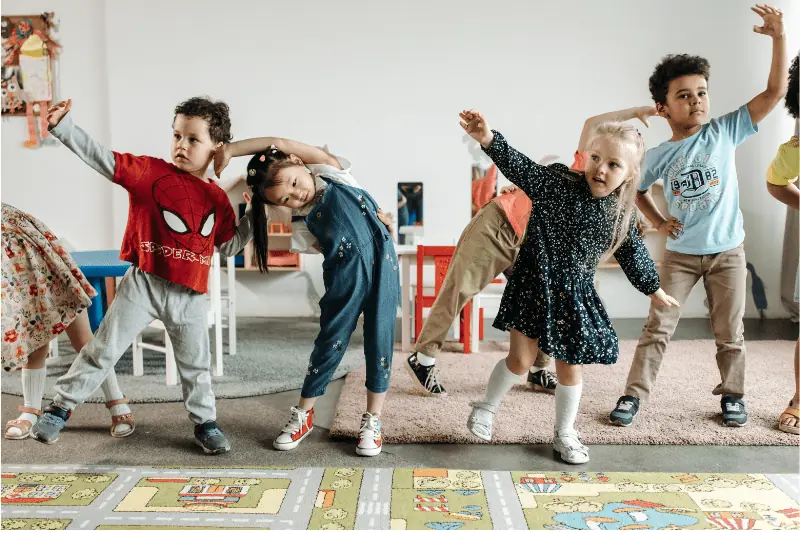Balance is an important skill for individuals of all ages, especially for children and young adults as it helps in developing motor skills, coordination, and stability.
Engaging in fun and creative balance exercises can not only improve physical health but also enhance cognitive function and focus.
In this article, we will explore 15 exciting and easy-to-do balance exercises that can be performed by kids and young adults.
[ez-toc]

Why Balance is Important for Kids and Young Adults
Balance is the ability to maintain a stable position while standing, walking, or engaging in any physical activity.
It is a crucial skill that helps in developing coordination, stability, and posture. In kids and young adults, a strong sense of balance can promote better focus, cognitive function, and overall physical health.
Research has also suggested that balance exercises can help reduce the risk of falls and injuries, which are common among children and young adults.
15 Fun and Creative Balance Exercises
- Tippy Toes: Stand on your tippy toes and hold the position for as long as possible. Repeat for a few minutes.
- One-Legged Stand: Stand on one leg and try to maintain balance for as long as possible. Repeat on the other leg.
- Tightrope Walk: Use a rope or a string to create a tightrope and try to walk across it without losing balance.
- Balancing Act: Use different objects such as books, blocks, or balls to create a balancing act. Try to balance the objects on your head, hand, or foot.
- Balancing Board: Use a balancing board or a balance cushion to improve stability and balance. Stand on the board and try to maintain balance.
- Hoop Jump: Place a hula hoop on the ground and try to jump in and out of it while maintaining balance.
- Balance Beam: Use a balance beam or a narrow board to walk across while maintaining balance.
- Wobble Cushion: Sit on a wobble cushion and try to maintain balance while moving.
- Hula Hoop Hop: Hold a hula hoop and hop on one foot while keeping the hoop around your waist.
- Plank Balance: Perform a plank pose and lift one leg off the ground while maintaining balance.
- Yoga Balance Poses: Try different yoga balance poses such as tree pose, warrior III, or half-moon pose.
- Ball Balance: Use a stability ball to improve balance. Sit on the ball and try to maintain balance while moving your legs or arms.
- Stilt Walking: Use stilts or homemade stilts to improve balance and coordination.
- Water Balancing: Try different balancing exercises in a pool or any body of water to improve stability and balance.
- Slackline Walking: Use a slackline or a tightrope to walk across while maintaining balance. Start with a low slackline and gradually increase the height as your skills improve.
These balance exercises are not only fun and engaging but also help in improving coordination, focus, and stability.
By incorporating these exercises into daily routines, kids and young adults can develop strong motor skills and reduce the risk of falls and injuries.
Tips for Safe and Effective Balance Exercises
While engaging in balance exercises, it is important to ensure safety and effectiveness. Here are some tips to keep in mind:
- Start with easy exercises and gradually increase the difficulty level.
- Always use proper equipment and gear.
- Perform balance exercises on a soft surface such as grass or carpet to reduce the risk of injury in case of a fall.
- Maintain proper posture and alignment during exercises.
- Consult with a healthcare professional before starting any new exercise routine, especially if you have a history of injuries or medical conditions.
By following these tips, you can ensure safe and effective balance exercises that promote overall physical and mental health.
How can kids improve their balance?
Balance is an essential skill for individuals of all ages, especially children and young adults.
Engaging in balance exercises not only improves physical health but also enhances cognitive function and focus. In this article, we have discussed 15 fun and creative balance exercises that can be performed by kids and young adults.
Tippy toes and one-legged stands are two easy-to-do exercises that require no equipment and can be performed anywhere.
These exercises can help improve stability and balance by challenging the leg muscles. The tightrope walk is another exercise that challenges balance and coordination, as the individual has to walk across a rope or string without losing balance.
Balancing acts involve the use of different objects such as books, blocks, or balls to create a balance challenge.
By balancing the objects on the head, hand, or foot, individuals can improve motor skills and focus. Balancing boards and cushions are other equipment that can be used to improve stability and balance.
The hoop jump and balance beam are two fun exercises that can be performed outdoors or indoors.
The hoop jump involves jumping in and out of a hula hoop while maintaining balance, while the balance beam requires walking across a narrow board while maintaining balance.
Wobble cushions and hula hoop hops are two exercises that challenge balance while moving.
Wobble cushions can be used for sitting or standing exercises, while hula hoop hops involve hopping on one foot while keeping the hoop around the waist.
Plank balance, yoga balance poses, and ball balance are exercises that challenge balance and coordination in different ways.
Plank balance involves performing a plank pose and lifting one leg off the ground while maintaining balance.
Yoga balance poses such as tree pose, warrior III, or half-moon pose can also help improve balance and focus. Ball balance involves sitting on a stability ball and moving the arms or legs while maintaining balance.
Stilt walking, water balancing, and slackline walking are more advanced exercises that require more skill and practice.
Stilt walking involves using stilts or homemade stilts to improve balance and coordination, while water balancing involves performing different balancing exercises in a pool or any body of water.
Slackline walking involves walking across a slackline or tightrope while maintaining balance.
When engaging in balance exercises, it is important to ensure safety and effectiveness. Starting with easy exercises and gradually increasing the difficulty level is crucial to prevent injury.
Using proper equipment and gear, performing exercises on a soft surface, maintaining proper posture and alignment, and consulting with a healthcare professional before starting any new exercise routine are other important tips to keep in mind.
Final Thoughts
In conclusion, balance exercises are essential for the development of motor skills, coordination, and stability in kids and young adults.
By incorporating fun and creative balance exercises into daily routines, individuals can not only improve physical health but also enhance cognitive function and focus.
Remember to always prioritize safety and consult with a healthcare professional before starting any new exercise routine.
FAQs
- What age group is suitable for these balance exercises?
These balance exercises are suitable for kids and young adults of all ages.
- How often should I perform these balance exercises?
You can perform these balance exercises daily or as often as you like. It is important to listen to your body and not overdo it.
- Do I need any special equipment for these exercises?
Some exercises may require equipment such as a balance board, hula hoop, or slackline. However, many exercises can be performed without any equipment.
- Can balance exercises help with posture?
Yes, by improving stability and coordination, balance exercises can also help with posture.
- Are balance exercises only beneficial for physical health?
No, balance exercises also promote cognitive function and focus, making them beneficial for overall mental health as well.
